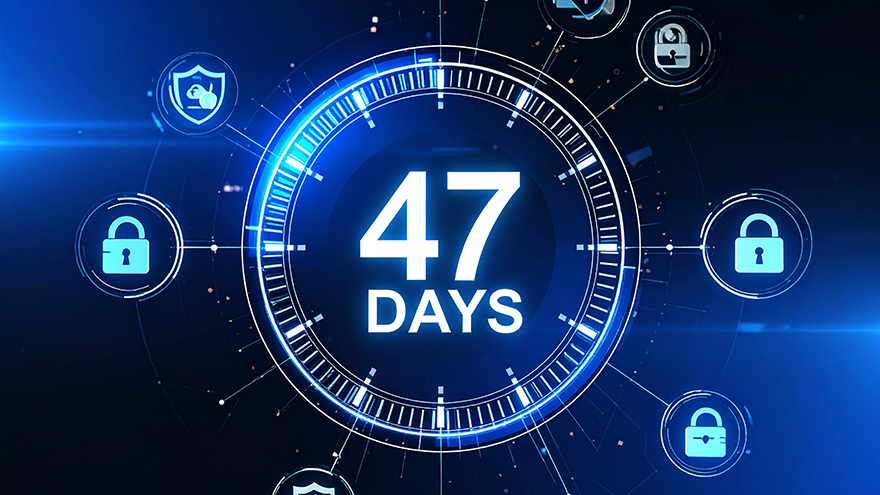
Have you ever been on a tight deadline, and suddenly, your organization’s core services go dark because a TLS certificate expired without warning? It’s a nightmare scenario no team wants to face.
Now, picture this happening eight times more often.
Starting in 2029, every public TLS certificate will have a maximum lifespan of just 47 days. Compared to today’s 398-day validity, this represents a seismic shift in digital security practices. And the ripple effects will be hard to ignore.
This move, championed by major industry leaders like Apple and Google and recently made official by the CA/Browser Forum, is designed to enhance security by reducing the risk of certificate compromise. It will also occur in a phased approach, beginning with a reduction to 200 days next year, 100 days in 2027, and finally, 47 days in 2029.
With this change, the TLS action lead time, the window between when a certificate policy change is announced and when it becomes enforceable, is rapidly closing. That means less time for organizations to prepare, test, and implement automation before shorter certificate lifespans become mandatory across the internet.
This transition to shorter lifecycles presents a monumental operational challenge. Manual certificate management will buckle under the strain of eight times as many renewals, increasing the risks of outages, compliance violations, and security breaches.
The question is clear: Are your teams prepared to handle this tidal wave of certificate renewals? If the answer isn’t a confident “yes,” it’s time to act. How, you ask? Below, I’ve outlined five practical steps to help you build greater efficiency, agility, and confidence into your certificate management strategy—before 47-day TLS certificate lifetimes become the norm.
1. Automate continuous certificate discovery and context
Before you can secure your TLS certificates, you need to know what you have and where they’re used. Without proper visibility, blind spots emerge, leaving critical systems vulnerable to outages. Think of it like trying to defend a castle you can’t fully map; you’re bound to miss a crag or two.
Start by implementing automated discovery tools to scan your environment, including on-premises servers, multi-cloud systems, and Kubernetes clusters. These tools should continuously update your certificate inventory in real time, providing clear insights into certificate locations, owners, expiration dates, and compliance status. A dynamic dashboard that categorizes certificates by status (active, expiring soon, expired) can be the difference between streamlined operations and chaotic firefighting.
Action item
Deploy a certificate lifecycle management solution that automates discovery and maintains a real time inventory. This ensures nothing slips through the cracks, reducing your risk of unplanned outages.

2. Automate renewal processes
Managing TLS certificate renewals manually isn’t just impractical; it’s impossible with the impending workload of 47-day lifespans. Picture yourself bailing water out of a sinking ship with nothing but a teaspoon—that’s what manual renewals will soon feel like.
Automation is the lifeboat, bringing speed, scale, and reliability to renewal processes. By leveraging the ACME protocol or API-driven workflows, you can ensure certificates are issued, renewed, and deployed accurately with minimal human intervention. This reduces the risk of human error and helps prevent outages caused by missed expiration deadlines.
Action item
Set up automated certificate renewal workflows integrated with your certificate authority (CA). Ensure these workflows renew certificates well before they expire, so you always stay ahead of schedule.
3. Establish centralized policies and workflows
As certificate lifespans shrink, the need for consistent and scalable processes grows. Otherwise, it’s like your team is running a relay—but everyone is setting their own pace.
Uncoordinated processes inevitably lead to chaos, and shortened validity periods demand centralized policies to ensure smooth transitions and operational harmony across teams.
Create global certificate policies that enforce validity standards, define renewal timelines, and pre-approve workflows to eliminate bottlenecks. Automated enforcement of these policies ensures compliance across departments and environments while reducing manual touchpoints.
Action item
Define centralized, policy-driven workflows that automate compliance checks and enforce best practices. These workflows should align with the 47-day validity requirement while maintaining scalability.
4. Integrate certificate management with DevOps tools
For DevOps teams, timing is everything. TLS certificates, primarily private but sometimes public for internet-facing services, are used extensively in CI/CD pipelines, Kubernetes clusters, and microservices architectures. Without streamlined access to certificates, teams may resort to risky shortcuts that bypass security protocols.
But you can’t afford for certificates to become the bottleneck in your development cycle. By integrating certificate management solutions with DevOps tools like Jenkins, Kubernetes, and Ansible, you can automate certificate provisioning and renewal directly within your development workflows, keeping new applications and updates encrypted and secured without sacrificing speed.
Action item
Work with your DevOps teams to enable plugin-based or API-driven integrations between certificate management platforms and DevOps tools. This will secure certificates while maintaining rapid deployment cycles.
5. Implement real time monitoring and reporting
Shortened certificate lifespans mean shorter intervals for errors to escalate. Relying on periodic checks isn’t enough to stay compliant and secure. Instead, continuous, real time monitoring acts as an early warning system, flagging potential issues before they snowball into outages or breaches.
Deploy monitoring tools that provide a clear view of your certificate landscape, including anomalies like misconfigurations or unauthorized usage. Automated reporting can also enhance compliance by providing detailed audit trails, proving your adherence to industry standards.
Action item
Invest in monitoring systems that deliver real time alerts for expiring certificates, policy deviations, and potential security flaws. This proactive approach ensures you stay ahead of emerging challenges.
Automation is the key to navigating a shorter certificate validity period
The move to 47-day TLS certificate lifespans isn’t just a change; it’s a challenge that will test your organization’s processes, tools, and agility. Relying on manual workflows isn’t sustainable. Instead, automation should be at the heart of your strategy.
Here’s how certificate renewal automation streamlines your TLS management:
- Automatic discovery: Identify certificates across on-premises and cloud environments in real time.
- Seamless renewals: Automate issuance, renewal, and deployment to scale with organizational needs.
- Integrated DevOps support: Ensure certificates are provisioned securely without slowing development cycles
- Proactive monitoring: Gain full visibility into certificate health, with continuous compliance checks and alerting for anomalies.
- Crypto agility: Adapt with resilience to cryptographic shifts and CA trust changes—without disruption or compromise.
By adopting a comprehensive TLS certificate lifecycle management solution, you’ll master the shift to shorter certificate lifespans while fortifying your organization’s overall security posture.
Act now to stay ahead of the closing TLS action lead time
The transition to 47-day TLS certificates is a significant leap forward for cybersecurity, but also demands preparedness to prevent disruptions.
Don’t wait until outages or compliance fines force your hand. Start preparing today by auditing your current certificate landscape. With CyberArk’s free Discovery Scan for Public TLS Certificates, you can gain insight into your external certificate landscape, helping you identify risks, blind spots, and expiring certificates before they become operational headaches.
George Parsons is head of public key infrastructure (PKI) strategy at CyberArk.























